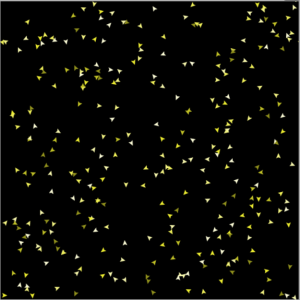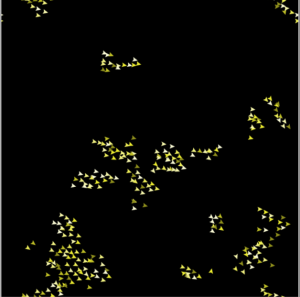This is the first article in our new series exploring and explaining the concepts that underlie our research. Many of our projects integrate highly involved, deeply technical theories and methods, which can be hard to understand without proper training. These posts are intended to break down those abstractions and put them in context.
COMPLEXITY
It’s a common sight at a park: a group of birds is gathered on the ground until a sound or motion startles one. That single bird leaps into the air and then suddenly the whole flock flies off in a flurry.You might not notice it, but as the birds swirl around the park and depart, they are actually following each other in intricate, precise trajectories. If you were watching, you might think the movement of the flock seems perfectly choreographed. And if you wanted to break down that process – calculate every flight path, every angle, every beat of wings – to recreate that stunning image of organization and interaction, the mathematics would rapidly outpace all but the most advanced scientists and mathematicians.
 But what if there was a simpler way to think about the structure that gives rise to this complex behavior? What if, rather than analyzing the flock as a whole, we instead looked at more simple rules, like “follow the bird in front of you”? Then, the complex pattern of group flight occurs naturally from the combination of each individual bird following that one basic rule. The order we see emerges “for free” from the bottom-up, rather than having to be imposed from above.
But what if there was a simpler way to think about the structure that gives rise to this complex behavior? What if, rather than analyzing the flock as a whole, we instead looked at more simple rules, like “follow the bird in front of you”? Then, the complex pattern of group flight occurs naturally from the combination of each individual bird following that one basic rule. The order we see emerges “for free” from the bottom-up, rather than having to be imposed from above.
Well, welcome to the world of complexity in the social and natural sciences, where small events blossom into entire ordered systems.

The key to complexity is the idea of non-linearity, or the idea that there are many systems in the world that do not behave in a direct, sequential fashion. Linearity often makes sense to us – that as you increase the force on a moving object (say, the rocket on a space shuttle), the object (in this case the shuttle) will move faster and faster, just as Newton’s laws predict. But not all systems behave in this orderly, intuitive way – in fact, few do. The flight patterns of birds in a park offer one example of a dynamic, non-linear system. And even if you don’t care much about birds or don’t spend any time in parks, complex systems are still all around you, affecting your daily life.
For example, let’s talk about the speed of your car in a traffic jam on a highway. To understand how fast you’re moving, we would have to think about how each driver speeds up or slows down in relation to other cars on the road, which in turn affects the speed of the drivers in front or behind them. One small interruption in this process, such as someone merging into a crowded lane, causes numerous individuals to slow down or switch their own lanes, which changes your speed even if you are several miles back! The “cause” here is the merger, but that variable is being mediated through a massive series of individual drivers. Their crowding may lead the next merger to have an even more dramatic result and so on and so on, eventually creating a jam.
This experience is known as a feedback loop, because the effects ‘feed back’ to influence the factors that caused them, and it is at the heart of what it means to be non-linear. Traffic jams thus reflect the power of small events (one merger) as well as the difficulty of pinning the fault onto any one of those small events (any one car).

Jams are anemergent phenomena, which is what we call something that arises out of the collective effects of a multitude of smaller decisions. To understand traffic jams, we therefore have to consider them in all their complexity – the same approach that we use to understand the earth’s climate, or cellular development, or markets, or any system with that same never-ending interplay between different levels of organization.
Research on complex systems has revolutionized a wide variety of fields, from thermodynamics and ecology to public health and neuroscience. At CMAC, we focus on the role of complexity in social systems, such as the interaction between psychological, cultural, and sociological factors that lead to religious change, immigrant integration or extremist violence. We account for the attitudes, norms, and experiences shaping the decisions of individuals, which in turn shape societies.
After developing formal or abstract models of the different variables and layers involved in a process, we utilize simulation or data analysis in order to test and sharpen our assumptions. Complex systems hover on the boundary between order and randomness, so simulation is invaluable for conceptualizing the range of different possibilities and getting a handle on the power of starting conditions. By treating the systems of this world through the lens of complexity, we can begin to see the simpler rules and ideas that can empower agents of change to make a more long-term difference.
For any inquiries or comments, please email admin@mindandculture.org.



